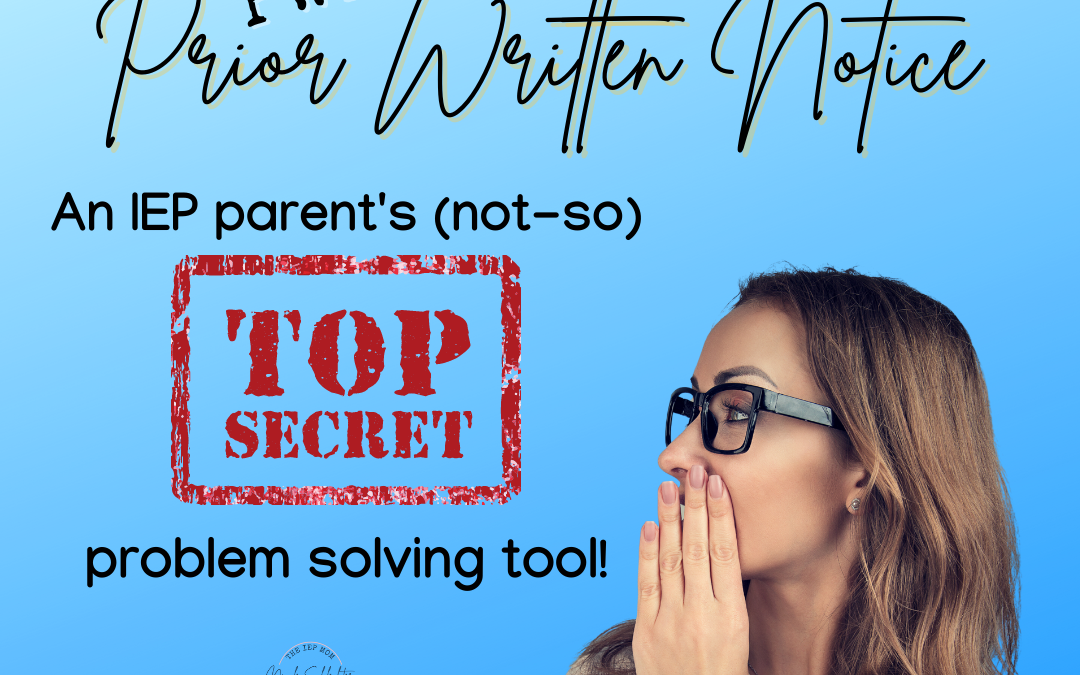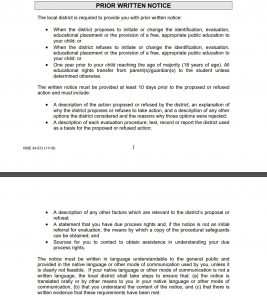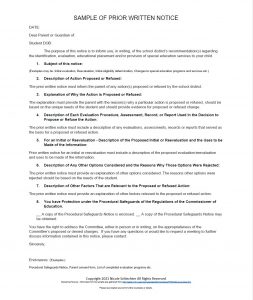One of the MOST effective and important advocacy tools we have is prior written notice, yet many parents aren’t aware it exists or what to do with it if it’s provided. To get straight to the point, parents are entitled to prior written notice anytime the school proposes a change or refuses a change for your child.
(See Sec. 303.421 Prior written notice and procedural safeguards notice)
So, what does that include?
- Content of notice. The notice must be in sufficient detail to inform parents about—
- (1) The action that is being proposed or refused;
- (2) The reasons for taking the action; and
- (3) All procedural safeguards that are available under this subpart, including a description of mediation in §303.431, how to file a State complaint in §§303.432 through 303.434 and a due process complaint in the provisions adopted under §303.430(d), and any timelines under those procedures.
(2) Native language.
(1) The notice must be—
- (i) Written in language understandable to the general public; and
- (ii) Provided in the native language, as defined in §303.25, of the parent or other mode of communication used by the parent, unless it is clearly not feasible to do so.
(2) If the native language or other mode of communication of the parent is not a written language, the public agency or designated EIS provider must take steps to ensure that—
- (i) The notice is translated orally or by other means to the parent in the parent’s native language or other mode of communication;
- (ii) The parent understands the notice; and
- (iii) There is written evidence that the requirements of this paragraph have been met.
So why is this important?
Let’s say your child has been receiving reading interventions for a year or more. Your child maybe has made some progress; however, they are still struggling. Curriculum is getting more difficult, ideas are more abstract, expectations are higher… and your child is still struggling to read at or close to grade level. Sound familiar?
Or maybe your child is doing their best to keep up in class, but they need frequent redirections, teachers are having to spend time repeating instructions 1:1, maybe your child needs the teacher to get the work completed and turned in despite accommodations like visual instructions or checklists.
In both of these situations you come to the team and request something specific. Maybe it’s specialized curriculum, maybe its an increase in related service minutes, maybe it’s a 1:1 or classroom aide. You bring the data to support the request (PS: whenever you ask for something at the IEP table, put it in writing and be ready to provide data to support your request.) and the team says something like, “we don’t do that here,” or “let’s wait and see how she does.” Both of those answers are not sufficient to deny your request so the school is legally obligated to provide you with prior written notice denying those requests and providing the reasoning (or the data) to support this denial.
This prior written notice is SO important, that it’s typically on the first page of your procedural safeguard. Check out IL’s here for reference or do a quick google search for your state to see specifics.
If you haven’t read your procedural safeguards yet, stop everything and go find them now. You NEED to understand them in order to be an effective advocate for your child.
Here is an example of what PWN may look like.
FREQUENTLY ASKED QUESTIONS:
PRIOR must mean before an IEP meeting right??
Nope. Prior actually means after a decision and before a change has been made.
How long does the school have to provide it?
IDEA law says that prior written notice must be given a “reasonable time” before the school will take action. There is no exact amount of time it should take the school to provide it.
Do I have to ask for PWN?
In some states, PWN is provided with every change, every proposal and every single denial. IDEA law states the school should provide it, however in my experience is it up to parents to request it most of the time.
How do I request PWN?
Always in writing. Your letter should state your requests, provide data or documentation or outline your disagreement to proposed changes.
For example: “We are requesting a highly qualified one on one paraprofessional for Mason to access FAPE (free appropriate public education) based on lack of progress indicated in IEP goals and report cards in addition to recommendations by Dr. KnowsBest clinical psychologist and Mrs. UniqueStudentNeeds Masons Occupational Therapist.”
What happens when I request PWN?
Often times your request is fulfilled because the school is unable to provide sufficient documentation to deny the request. Or we have developed a record that can help in future IEP meetings, Mediation, Due Process, or Court. Refer back to your procedural safeguards for dispute resolution options.
Overall PWN is a documentation tool and we all know that without proper documentation, our requests or disagreements or concerns may as well have never happened. Everything needs to be documented. This is why I always suggest reading the notes after a meeting to ensure the documentation is correct. You don’t need to request PWN during a meeting either, you can always wait until after the meeting to put your requests or disagreement in writing.



